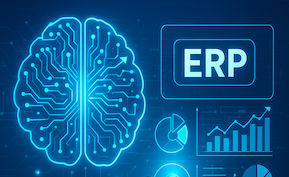Artificial Intelligence
ERP
ROI Calculator: How Much Can AI ERP Save Your Business?

Artificial intelligence-enhanced ERP systems deliver measurable business value through operational efficiency, improved decision-making, and competitive advantages. This comprehensive ROI analysis provides frameworks and calculators to quantify the financial benefits of AI ERP implementation.
Understanding AI ERP ROI Components
Hard Cost Savings:
– Labor cost reduction through automation
– Error prevention and rework elimination
– Inventory optimization and carrying cost reduction
– Energy and resource efficiency improvements
Soft Benefits:
– Improved customer satisfaction and retention
– Enhanced employee productivity and satisfaction
– Better compliance and risk management
– Competitive advantage through superior insights
Revenue Enhancement:
– Faster time-to-market for new products and services
– Improved pricing optimization
– Cross-selling and upselling opportunities
– Market expansion through operational scalability
Detailed ROI Calculation Framework
Labor Cost Reduction Analysis
Document Processing Automation:
– Current manual processing time: _____ hours per month
– Hourly labor cost (including benefits): $____
– AI automation efficiency: 80% time reduction
– Monthly savings: (Hours × Cost × 0.80) = $____
– Annual savings: Monthly savings × 12 = $____
Financial Close Process:
– Current close time: _____ days per month
– Finance team size: _____ people
– Average daily cost per person: $____
– AI-enabled close time: 3-5 days
– Time savings: _____ days per month
– Monthly savings: (Days saved × Team size × Daily cost) = $____
– Annual savings: Monthly savings × 12 = $____
Customer Service Optimization:
– Current service requests per month: _____
– Average handling time per request: _____ minutes
– Hourly service team cost: $____
– AI assistance efficiency gain: 40% time reduction
– Monthly time savings: (Requests × Minutes × 0.40 ÷ 60) hours
– Monthly cost savings: Time savings × Hourly cost = $____
– Annual savings: Monthly savings × 12 = $____
Inventory and Supply Chain Optimization
Demand Forecasting Accuracy:
– Current inventory carrying cost: $_____
– Stockout cost per incident: $_____
– Current forecast accuracy: ____%
– AI forecast accuracy: 85-95%
– Accuracy improvement: ____%
– Inventory reduction potential: 15-25%
– Annual carrying cost savings: Current cost × 0.20 = $____
– Stockout reduction savings: (Incidents avoided × Cost per incident) = $____
– Total supply chain savings: $____
Purchasing Optimization:
– Annual procurement spend: $_____
– AI price optimization potential: 5-15%
– Supplier negotiation improvement: 3-8%
– Total procurement savings: Spend × (Optimization % + Negotiation %) = $____
Quality and Error Reduction
Error Cost Elimination:
– Current error rate: ____%
– Cost per error (rework, customer impact): $____
– Transaction volume per month: _____
– Current monthly error cost: Volume × Error rate × Cost per error = $____
– AI error reduction: 60-80%
– Monthly savings: Current error cost × Reduction % = $____
– Annual savings: Monthly savings × 12 = $____
Industry-Specific ROI Models
Manufacturing ROI Calculator
Predictive Maintenance Savings:
– Equipment downtime cost per hour: $____
– Current unplanned downtime hours per month: ____
– Preventive maintenance cost premium: ____%
– AI prediction accuracy: 90%+
– Downtime reduction: 30-50%
– Monthly savings: (Downtime hours × 0.40 × Hourly cost) = $____
– Annual savings: Monthly savings × 12 = $____
Quality Control Optimization:
– Current defect rate: ____%
– Product volume per month: _____
– Cost per defective unit (scrap, rework, warranty): $____
– AI quality prediction accuracy: 95%+
– Defect reduction potential: 40-60%
– Monthly quality savings: (Volume × Defect rate × 0.50 × Unit cost) = $____
– Annual savings: Monthly savings × 12 = $____
Distribution ROI Calculator
Route Optimization:
– Monthly delivery routes: _____
– Average fuel cost per route: $____
– Driver time per route: _____ hours
– Hourly driver cost: $____
– AI route efficiency improvement: 15-25%
– Monthly fuel savings: (Routes × Fuel cost × 0.20) = $____
– Monthly labor savings: (Routes × Hours × 0.20 × Hourly cost) = $____
– Annual savings: (Monthly fuel + labor savings) × 12 = $____
Inventory Turnover Improvement:
– Current inventory value: $_____
– Current inventory turns per year: ____
– Target turns with AI optimization: 20% improvement
– Carrying cost percentage: 15-25%
– Annual carrying cost savings: (Inventory value × 0.20 × Carrying cost %) = $____
Professional Services ROI Calculator
Resource Utilization Optimization:
– Number of billable resources: ____
– Average hourly billing rate: $____
– Current utilization rate: ____%
– Target utilization with AI: 85%+
– Utilization improvement: ____%
– Annual revenue increase: (Resources × 2080 hours × Rate × Improvement %) = $____
Project Profitability Improvement:
– Annual project revenue: $_____
– Current average project margin: ____%
– AI project optimization potential: 20% margin improvement
– Annual profit increase: (Revenue × Current margin × 0.20) = $____
Implementation Investment Analysis
Software and Licensing Costs
AI ERP Subscription (Annual):
– Number of users: ____
– Cost per user per month: $150-250
– Annual licensing cost: Users × Monthly cost × 12 = $____
Implementation Services:
– Project complexity: Basic / Standard / Complex
– Basic implementation: $500K-1M
– Standard implementation: $1M-3M
– Complex implementation: $3M-10M+
– Selected implementation cost: $____
Training and Change Management:
– User training cost: $1,000-2,500 per user
– Change management consulting: $100K-500K
– Total training investment: $____
Total Investment Summary
– Annual software licensing: $____
– Implementation services: $____
– Training and change management: $____
– Total 3-Year Investment: $____
ROI Calculation Results
Annual Benefit Summary
– Labor cost reduction: $____
– Inventory and supply chain optimization: $____
– Quality and error reduction: $____
– Industry-specific savings: $____
– Total Annual Benefits: $____
3-Year ROI Analysis
– Total 3-year benefits: Annual benefits × 3 = $____
– Total 3-year investment: $____
– Net 3-Year Value: Benefits – Investment = $____
– ROI Percentage: (Net value ÷ Investment) × 100 = ____%
– Payback Period: Investment ÷ Annual benefits = ____ years
Risk-Adjusted ROI Scenarios
Conservative Scenario (70% of projected benefits)
– Adjusted annual benefits: Total benefits × 0.70 = $____
– Conservative 3-year ROI: ____%
– Conservative payback period: ____ years
Aggressive Scenario (130% of projected benefits)
– Enhanced annual benefits: Total benefits × 1.30 = $____
– Aggressive 3-year ROI: ____%
– Aggressive payback period: ____ years
ROI Optimization Strategies
Maximize Quick Wins:
– Focus on high-impact, low-complexity implementations first
– Prioritize processes with clear automation potential
– Target areas with measurable error reduction opportunities
Scale Successfully:
– Plan phased rollout to capture benefits incrementally
– Build internal AI expertise to reduce ongoing consulting costs
– Leverage AI insights for continuous improvement initiatives
Measure and Optimize:
– Establish baseline metrics before implementation
– Monitor actual vs. projected benefits monthly
– Adjust processes based on AI recommendations and performance data
Conclusion
AI ERP implementations typically deliver 25-40% ROI within three years through a combination of cost reduction, operational efficiency, and revenue enhancement. Organizations that carefully plan their implementation and focus on high-impact use cases can achieve payback periods of 18-24 months.
Use this framework to build a compelling business case for AI ERP investment and track actual performance against projections to maximize long-term value creation.






